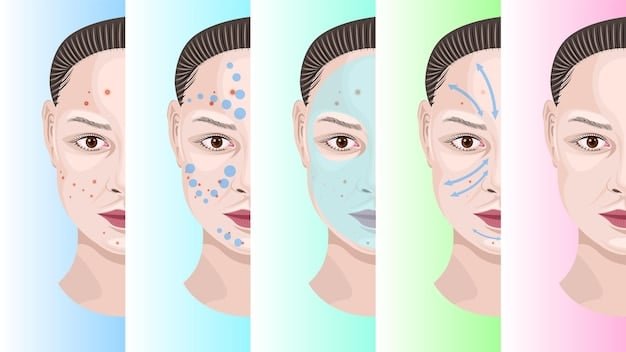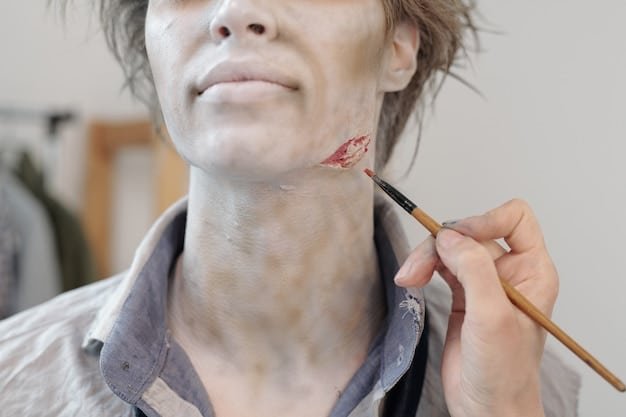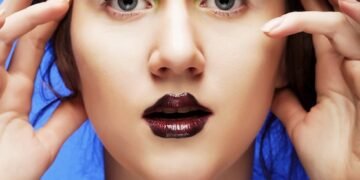How to Cover Acne Scars with Makeup: US Guide

Covering acne scars with makeup involves a strategic approach, starting with prepping the skin, using color correction to neutralize redness or discoloration, applying a full-coverage foundation, and setting everything with powder for a flawless complexion.
Dealing with acne scars can be frustrating, but with the right makeup techniques, you can achieve a flawless complexion. This step-by-step guide, tailored for the US market, will show you how to cover acne scars with makeup effectively, giving you the confidence to face the world with radiant skin.
Understanding Acne Scars
Before diving into the makeup application process, it’s important to understand the different types of acne scars. Knowing the type of scars you have will help you choose the right products and techniques for optimal coverage.
Acne scars come in various forms, each requiring a slightly different approach when it comes to makeup. Here are the main types:
Types of Acne Scars
- Ice Pick Scars: These are deep, narrow scars that look like small holes in the skin. They are often the most challenging to cover completely.
- Boxcar Scars: These scars are wider and have well-defined, vertical edges. They can be shallow or deep.
- Rolling Scars: These scars create a wave-like appearance on the skin, often caused by tethering of the skin to deeper structures.
- Hypertrophic Scars: These are raised scars that occur when the body produces too much collagen during the healing process.
- Post-Inflammatory Hyperpigmentation (PIH): While not technically scars, these are dark spots left behind after acne heals.
Understanding these scar types is the first step. Understanding the products and techniques will allow you to achieve a flawless look.
Recognizing your scar type is crucial for customizing your makeup routine. For example, ice pick scars may require targeted filling techniques, while PIH might benefit more from color correction.

Essential Makeup Products for Covering Acne Scars
Achieving flawless coverage of acne scars requires a strategic selection of makeup products. Each product plays a crucial role in creating a smooth, even canvas.
From primers to setting sprays, here’s a breakdown of the essential products you’ll need:
The Must-Have Makeup Arsenal
- Primer: A good primer creates a smooth base, filling in pores and uneven texture. Choose a silicone-based primer for best results.
- Color Corrector: This helps neutralize redness or discoloration. Green correctors are ideal for red acne scars, while peach correctors can brighten dark spots.
- Full-Coverage Foundation: Opt for a foundation that provides high coverage without feeling heavy. Look for non-comedogenic formulas to avoid clogging pores.
- Concealer: A creamy, full-coverage concealer is essential for spot-treating stubborn scars and blemishes.
- Setting Powder: This locks in the makeup and prevents it from creasing or fading. Choose a translucent powder for a natural finish.
Selecting the right products is half the battle. Investing in high-quality, full-coverage makeup can make a significant difference in the final result. Don’t skimp on these essentials!
Step-by-Step Makeup Application for Acne Scar Coverage
Now, let’s get into the practical steps of how to cover acne scars with makeup. Follow these instructions carefully for a seamless finish.
The key is layering products strategically to conceal imperfections and create a smooth, even skin tone:
- Prep Your Skin: Start with a clean, moisturized face. This ensures that the makeup goes on smoothly and lasts longer.
- Apply Primer: Use a silicone-based primer to fill in pores and even out the texture of your skin. Focus on areas with prominent scars.
- Color Correct: Apply a green color corrector to any red acne scars. Use a small brush for precise application.
By following these steps, you can create a flawless canvas that camouflages acne scars and boosts your confidence.
Techniques for Concealing Different Types of Acne Scars
As mentioned earlier, different types of acne scars require different concealing techniques. Here’s a closer look at how to address each type effectively.
Each scar type requires a strategic approach to application, and choosing the right technique will make the biggest difference.
Concealing Scar Types
- Ice Pick Scars: Use a pointed brush to apply concealer directly into the scar. Pat gently to blend.
- Boxcar Scars: Fill the scar with a thick concealer using a small brush. Set with powder.
- Rolling Scars: Use a smoothing primer to minimize the appearance of texture. Apply foundation and concealer as needed.

Remember, practice makes perfect. Experiment with different techniques to find what works best for your specific skin and scar type.
Maintaining Your Makeup Look and Preventing Future Breakouts
Once you’ve perfected your makeup look, it’s important to maintain it throughout the day. Additionally, taking steps to prevent future breakouts will help minimize the need for heavy coverage in the long run.
From touch-ups to skincare, here’s how to maintain your flawless finish:
Makeup Maintenance Tips
- Use Blotting Papers: Keep blotting papers on hand to absorb excess oil without disturbing your makeup.
- Set with Spray: A setting spray helps lock in your makeup and keeps it looking fresh for hours.
- Touch-Ups: Carry a compact with your foundation or concealer for quick touch-ups throughout the day.
Prioritizing skincare and using the right products can reduce inflammation. Reduce the appearance of severe acne scars over time.
Skincare Routine to Prevent Future Breakouts and Reduce Scarring
Alongside makeup application, a consistent skincare routine is essential for preventing breakouts and reducing the appearance of existing scars. Here are few ways to do this.
A solid skincare routine will make the products blend and adhere to your skin in a more even manner.
Effective Skincare
- Gentle Cleansing: Wash your face twice a day with a mild cleanser to remove dirt, oil, and makeup.
- Exfoliation: Exfoliate 1-2 times a week to slough off dead skin cells and promote cell turnover.
- Sunscreen: Protect your skin from the sun with a broad-spectrum sunscreen. Sun exposure can worsen hyperpigmentation and scarring.
Ultimately the goal is to have clear skin that can be appreciated makeup or no makeup.
| Key Point | Brief Description |
|---|---|
| ✨ Primer | Creates a smooth base for makeup application. |
| 🟢 Color Correction | Neutralizes redness from acne scars. |
| ✅ Full Coverage Foundation | Evens out skin tone and covers scars. |
| ☀️ Sunscreen | Protects skin and prevents hyperpigmentation. |
FAQ
▼
Silicone-based primers are typically best, as they help fill in pores and create a smooth canvas to apply makeup on.
▼
Use green to neutralize redness from acne scars, and peach or orange correctors for dark spots or hyperpigmentation on deeper skin tones.
▼
A full or medium coverage foundation that is buildable is best because it has the ability to cover any dark spots or noticeable textures that you may notice.
▼
Yes, if you aren’t thoroughly washing your face the night of, your pores might get clogged, leading to even worse breakouts.
▼
Apply primer before concealer and foundation. Also setting powder will help prevent this by creating a barrier, and filling the skin’s textural inconsistencies.
Conclusion
With the right products, techniques, and skincare, you can confidently cover acne scars with makeup and achieve a flawless complexion. Whether you’re dealing with ice pick scars, boxcar scars, or post-inflammatory hyperpigmentation, this guide provides the tools and knowledge you need to put your best face forward in the US market.





